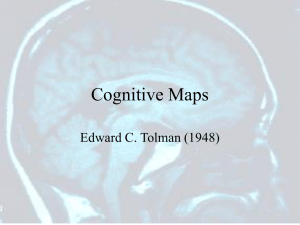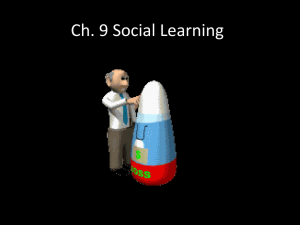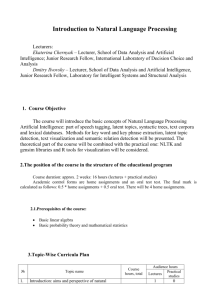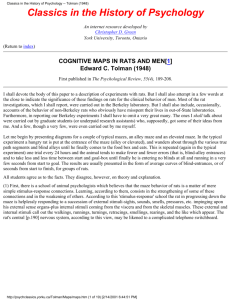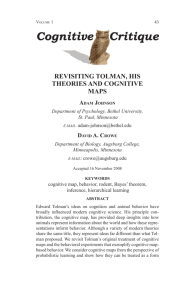What is Learning? - University of Nairobi
advertisement
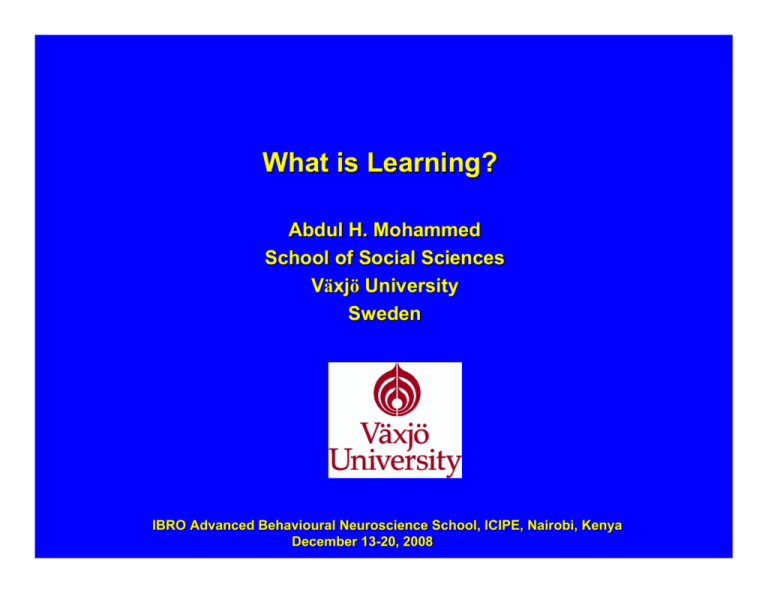
What is Learning? Abdul H. Mohammed School of Social Sciences Växjö University Sweden IBRO Advanced Behavioural Neuroscience School, ICIPE, Nairobi, Kenya December 13-20, 2008 Lund October 2007 Carolus Linnaeus (1707–1778). Species Plantarum (Stockholm, 1753). Species Plantarum is the landmark work in which Linnaeus applied his integrated system of classifying, naming and describing plants to account for all plants then known to western science. His system of binomial nomenclature was first used comprehensively here. He analyzed much of the previous botanical literature and linked references from previously published descriptions to his own treatments of plants, providing a synthesis of botanical knowledge on an unprecedented scale. Statue of Linné outside the city library in Lund The Linnaean garden has been maintained and can still be visited in Uppsala today What is Learning? Definition of Learning “To gain knowledge or understanding of, or skill in, by study, instruction, or investigation.” Definition of Learning From Textbooks: Learning is a relatively permanent change in behavior, or behavior potential, that occurs as the result of practice or experience. Latent learning We have knowledge we do not know we have --and may never know until an appropriate stimulus is experienced. This is latent learning. Socrates: “I know that I do not know” Latent Learning is a form of learning that is not immediately expressed in an overt response; it occurs without obvious reinforcement to be applied later. Latent learning is when an organism learns something in its life, but the knowledge is not immediately expressed. It remains dormant, and may not be available to conciousness until specific events/experiences might need this knowledge to be demonstrated. For instance a child may observe a parent setting the table or tightening a screw, but does not act on this learning for a year; then he finds he knows how to do these things, even though he has never done them before. • • Tolman, E. C. & Honzik, C. H. "Insight" in Rats, University of California Publications in Psychology, 1930. Tolman’s Latent Learning Latent Learning: A Classic Experiment (Tolman & Honzik, 1930) GROUP 1: On every trial, these rats received food when they reached the goal box. GROUP 2: These rats never received food. They were simply removed from the maze when they got to the goal box. GROUP 3: These rats got no food on Trials 1 to 10. But on Trial 11, and every trial afterwards, they received a food reward. GR 1 — GR 3 — 6 8 GR 2 — 2 4 Group 3 matched Group 1, and then did even better! 0 Average Errors 10 Latent Learning: A Classic Experiment (Tolman & Honzik, 1930) 1 10 11 Trials (1 Trial per Day) 17 Latent Learning: A Classic Experiment (Tolman & Honzik, 1930) Conclusion We must observe a change in behavior to say that learning has occurred, but if no change occurs, we can draw no conclusion. Learning may be present “beneath the surface.” This supports a distinction between learning and performance. Tolman on Why He Worked with Rats “They do not go on binges the night before one has planned an experiment; they do not kill each other off in wars; they do not invent engines of destruction, and if they did, they would not be so inept about controlling such engines; they do not go in for either class conflicts or race conflicts; they avoid politics, economics, and papers on psychology. They are marvelous, pure, and delightful.” Tolman (1945) Beyond Freedom and Dignity “Beyond Freedom and Dignity [1971] was a misleading title. It suggested that I was against freedom and personal worth. I did not advocate imposing control; control existed and should be corrected.” Skinner (1976) Sept. 1971 Operant conditioning is the modification of behavior (the actions of animals) brought about by the consequences that follow upon the occurrence of the behavior. In simple terms, behavior operates on the environment producing various effects. Operant conditioning differs from Pavlovian conditioning, like the dog's salivation or the knee-jerk, has neither much effect on the environment, nor is its occurrence changed by its effectiveness or ineffectiveness in the environment. scatter hoarding Why do scatter hoarding birds store very much food? Extreme environment: - short days, 3h - low temperatures, -20° - - 30° C - little food (no insects or seeds) - long winters, nov - apr Why store food? - fat is expensive to carry - caches are insurance Pernau J.F.A, 1720: Angenehme Landlust allerhand Vögel zufangen und abzurichten The one who searches for evidence that the animals have some kind of mind (Verstand) should let a marsh tit fly in a room...put a tree in the room...let it get used to the environment. Then starve it for half a day...let is store hemp seeds from a tray. When it retrieves the seeds it appears to possess some kind of memory that cannot be explained with "Instinctu naturali". Pernau J.F.A, 1720: - hc important for spatial memory - food hoarding birds retrieve food by memory - large scale caching requires special memorisation ability - memory specialisation may require hc enlargement - survival of baby neurons increase during intensive hoarding - families with hoarders have larger hippocampi than non hoarders Categorization of hoarding between species 1. Nonhoarders 2. Hoarders of intermediate specialisation 3. Highly specialised hoarders Episodic-likememory during cache recovery by scrub jays Nicola S. Clayton & Anthony Dickinson The recollection of past experiences allows us to recall what a particular event was, and where and when it occurre a form of memory that is thought to be unique to humans. It is known, however, that food-storing birds remember the spatial location and contents of their caches. Scrub jays (Aphelocoma coerulescens) remember ‘when’ food items are stored Jays demonstrate memory of where and when particular food items were cached, thereby fulfilling the behavioural criteria for episodic-like memory in non-human animals. The ”What, Where and When” of unique experiences Correlation between hoarding capacity and hippocampus volume - storing could select for larger hippocampus - storing could directly affect hippocampus morphology ? Anders Brodin, Lund University “Insect and mammalian olfactory systems are strikingly similar. Therefore, Drosophila can be used as a simple model for olfaction and olfactory learning. However, the brain of adult Drosophila is still complex. We therefore chose to work on the larva with its yet simpler but adult-like olfactory system.” Martin Heisenberg • Test performance of individuals from two treatment conditions is compared: One received odorant A with the positive reinforcer and odorant B with a negative one (A+/ B-); During test, differences in choice of A versus B of individuals having undergone these different treatment conditions is seen thus indicating associative learning. Rodents are able to: • discriminate a novel from a familiar object (onetrial object recognition), • detect a mismatch between the past and present location of a familiar object (one-trial object–place recognition) • can discriminate different objects in terms of their relative recency (temporal order memory), i.e., which one of two objects has been encountered earlier. The novelty-preference paradigm • • • • • One-trial object recognition task One-trial object–place recognition task One-trial object–context recognition task Temporal order memory task Episodic-like memory task Learning and Memory: Multiple Memory Systems Model Thompson and Kim (1996) Proc. Natl. Acad. Sci. USA, 93, 13 439. Object recognition memory – a common test of declarative memory Declarative memory is defined as the conscious memory for facts and events and is often further divided into episodic memory (memory for personal events) and semantic memory (memory for general information) (Squire and Zola-Morgan,1988; Squire and Zola, 1996). Delay Delay I. Novel object II. Object-place recognition Delay Delay Object-context Delay Delay Temporal order Delay Delay Episodic-like memory Sources of Phenotypic Variance • Genetic Effects • Systematic Environmental Treatments • Uncontrolled Pre-Test (Rearing) Environmental Effects • Idiosyncratic Environmental Effects that Occur During Testing Idiosyncratic Testing Environment Effects • The Bad Day Effect • Events that occur prior to and/or during testing that alter test behaviour (eg. a large temperature fluctuation or a disturbance in the colony or testing room) •The Clumsy Test Effect •Stresses to the animal induced just prior to testing (eg. unusual difficulty extracting the animal from its home cage or in placing it in the test apparatus) •The Stinky Apparatus Effect •Uncontrolled residual sensory cues in the test apparatus that alters the subject´s behaviour •The Faulty Scoring Effect •Temporary data recording problems, ranging from altered sensitivity of electronic monitoring devices to inattentive observers who are scoring behaviour •The Slammed Door Effect •Sudden sensory intrusions or disturbances that occur during testing •The ”What do I do now” Effect •Variations in tester responses to unanticipated actions of the animal being tested (eg. jumping from the apparatus) Tolman’s Cognitive Maps


